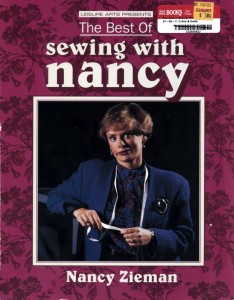 The Best of Sewing With Nancy is almost like a continuation of Nancy Zieman’s book, 10, 20, 30 Minutes to Sew I reviewed recently. It follows the same format of illustrated, step-by-step instructions for completing a variety of sewing tasks. I got my copy from Alibris for $1, along with 10, 20, 30 Minutes to Sew.
The Best of Sewing With Nancy is almost like a continuation of Nancy Zieman’s book, 10, 20, 30 Minutes to Sew I reviewed recently. It follows the same format of illustrated, step-by-step instructions for completing a variety of sewing tasks. I got my copy from Alibris for $1, along with 10, 20, 30 Minutes to Sew.
This book rounds up the most popular topics from the first decade or so of the Sewing with Nancy series on PBS. Each chapter reads like a small book on its topic, and covers content presented in several episodes of the TV series. With some expansion, each chapter could indeed have been a standalone book.
The chapter topics are:
- Heirloom sewing – Techniques for joining lace, pintucking, double-needle work, embroidery and decorative scallops and bridges.
- Quilted fashions – Quilting techniques used as fashion design features for garment sewing. This chapter also covers some basic quilting techniques and is sort of a gateway drug to full-on quilting.
- Lingerie – Techniques for applying stretch lace, elastic, trims and other frilly bits. Also covers altering patterns to work well as lingerie and includes instructions for specific projects.
- Speed tailoring – Shows how to create a tailored jacket using an entirely alternate set of techniques than those used by traditional tailors. Fusible interfacing and machine stitching replaces traditional padding, hair canvas, hand-basting and hand-stitching.
- Designer touches – Applique techniques, cutwork, as well as charted needlework. Charted needlework is a sort of poor person’s embroidery, done on a conventional machine by sewing a design using zigzag stitches, applied over heavy needles arranged in parallel. This book was written in the early ’90s, so I’m not sure much of the material in this chapter is useful now. I get the impression most people who do this type of decorative work have moved on to computerized machine embroidery.
For me, my interest is menswear and the tailoring chapter is worth the entire book. Though a women’s jacket is presented, the techniques should apply equally well to a men’s blazer or suit jacket. Men’s jackets have some features not found on women’s jackets, such as back vents, but the instructions for making sleeve vents can probably be adapted for this purpose.
I also had some hopes for the lingerie chapter, that some techniques here might also be useful for men’s undergarments. But aside from instructions for attaching elastic on waists and leg openings, there is not much here of personal interest.
Like 10, 20, 30 Minutes to Sew, this book ends with an abbreviated introduction to basic sewing, but it’s not something I would use in place of a good beginner’s book.
In summary, if you have an interest in any of the topics covered by this book, it’s definitely worth finding a used copy. The diagrams are clear and easy to follow, and Nancy Zieman offers plenty of tips and tricks to help your project succeed.

